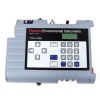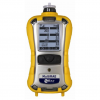Volatile Organic Compounds (VOCS) are carbon based compounds that pose a significant health hazard due to their toxicity. VOCs in large concentrations can easily be present in the air without us always knowing due to lack of odor or color. Other VOCs in higher concentrations are readily noticeable by odor such as gasoline vapors which are comprised of several different VOCs.
Even very small levels of VOCs over a period of time can cause long term damaging effects to human health and thus must be monitored. Some VOCs, if allowed to reach high concentrations, can be extremely volatile and sometimes combustible.
Three detecting technologies are widely used to determine the presence and concentration of VOCs in a given area or from a sample point. They are photoionization (PID), flame ionization (FID), and catalytic bead. The PID ionizes samples using various UV lamps i.e. 9.8 eV/10.6 eV/11.7eV depending on the volatile's ionization potential. The FID uses a hydrogen powered flame to ionize samples. The catalytic bead catalytically oxidizes pumped samples across a heated element that is incorporated into a Wheatstone bridge. Once ionized, an electrical signal is then interpreted by the instrument being used and reflected in either parts per million (ppm), parts per billion (ppb) or percent (%).
These handheld meters are used by environmental professionals and industrial hygienists to determine leaks along pipelines or from underground storage tanks, levels when removing VOCs through various remediation processes such as air sparging or vacuum recovery, and when investigating health hazards in the workplace or home. The proper monitor can be selected depending upon what anticipated VOCs there are to be present.
The first thing you need to determine is if Methane could be a contributing factor. If so, the use of a FID or Catalytic Bead device must be employed because of the PIDs inability to detect for Methane. If your sample area is not contaminated by Methane, then all three options are viable given a few constraints that you may or may not impose. Consider the following questions:
- Do you need an instrument capable of reading in % (over 10,000 ppm) like the Thermo TVA-1000? If low levels down to the ppb range are your chief concern, the RAE ppbRAE is the instrument of choice.
- Do you have access to Ultra High Purity Hydrogen? If not, you cannot choose an FID like a Thermo TVA-1000 since it utilizes Hydrogen as the fuel source for the instrument's flame, not to mention when traveling the instrument is a dangerous good.
- Do you need to discern between Methane levels and other VOCs present? Then you should consider the Thermo TVA-1000 outfitted with a charcoal filtering tip.
- Do you want to data log the samples taken? Then consider the RAE MiniRAE 3000, RAE ppbRAE, or Thermo TVA-1000.
- What is the ionization potential of the volatile present? Knowing this you can determine what lamp strength is required if using a PID.
- Are you conducting studies where high humidity and high VOCs will be present? Then I would consider the Bacharach TLV Sniffer (Note, this unit will not data log).
- Are you interested in monitoring for VOCs and other toxic gases present for indoor air quality or confined spaces? Then consider using a RAE MultiRAE 4-Gas with PID which employs the use of multiple gas sensors and a PID.
Upon answering the above mentioned questions the professional will be well equipped to determine the instrument needed for their given scope of work.



